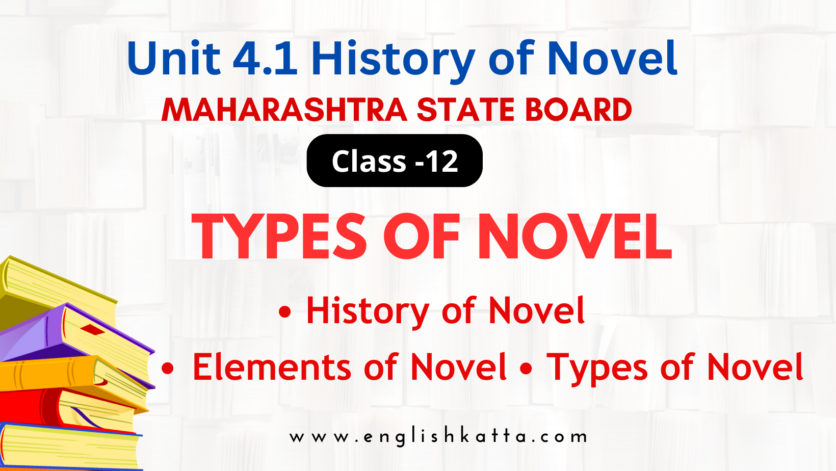TYPES OF NOVEL Class 12
(Unit 4.1 History of Novel Class 12th Maharashtra State Board)
In this post, you’ll find an overview of Types of Novel from Unit No.4.1 of Class 12 English, the History of Novel. There are different types of novel in English literature such as Picaresque novel, Realistic novel, Epistolary novel, Gothic novel, Stream-of -Consciousness novel etc.
The following article on Types of Novel from Unit No.4.1 of Class 12 English, the History of Novel. It would be helpful for 12th std students in the examination.
TYPES OF NOVEL
Maharashtra State Board Class 12 English Yuvakbharati Solutions Chapter 4.1 History of Novel
1. Picaresque Novel:
The Picaresque Novel originated in 16th-century Spain. The word Picaresque is derived from the Spanish word Picaro which means a rouge or rascal. It basically deals with the adventure of the protagonist, who is an eccentric or disreputable person, in an episodic form.
e.g. 1. Miguel De Cervantes’ Don Quixote – published in two parts 1605 and 1615.
2. Thomas Nash – Unfortunate Traveller – (1594)
3. Daniel Defoe’s Moll Flanders (1722) – The Protagonist is a thief and prostitute
- Henry Feilding’s Joseph Andrews (1742) , Jonathan Wild (1743)
2. Epistolary Novel :
The word ‘epistolary’ derives from the Latin word ‘epistola,’ which means a letter.
The epistolary novel is in which the writer presents the narrative through a series of correspondence or other documents.
In this kind of novel, the main character corresponds with others through letters. Although letters are the most common basis for epistolary novel, diary entries are also a popular form of this type.
e.g. 1. Samuel Richardson’s Pamela or Virtue Rewarded ( 1740) and Clarissa Harlowe (1749)
3. Historical Novel :
The historical novel is a work of fiction where the setting, manners, characters and events are derived from history.
Sir Walter Scott is considered as the proponent of this type of the novel.
4. Realistic Novel :
The realistic novel is a fiction that gives the effect of realism.
Sometimes this is also called a novel of manner.
It can be characterized by its complex characters with mixed motives that are rooted in the social class.
The characters in the realistic novel interact with other characters and undergo plausible and everyday experiences.
e.g.- 1. Mark Twain’s- The Adventures of Huckleberry Finn
2. Jay Asher’s – Thirteen Reasons Why
5. Gothic Novel :
The novels that include terror, mystery, horror, thriller, supernatural, death or decay or haunted buildings are called Gothic novels.
e.g. 1. Horace Walpole’s – The Castle of Otranato (1764)
6. Autobiographical Novel :
The Autobiographical novel is the novel based on the life of the author.
However, the author changes the places and names of characters or even may change or avoid certain details of his life.
It may or may not be in the first-person narration.
e.g. 1. Charles Dickens – David Copperfield
2. D. H. Lawrence’s – Sons and Lovers
3. Sachin Tendulkar’s – Playing It My Way
7. Allegorical Novel :
An allegory is a story that bears more than one level of meaning.
The surface meaning of such novel is different from the symbolic meaning of it.
The symbolic meaning of an allegory may be political, religious, historical or Philosophical.
e.g. George Orwell’s – Animal Farm
8. Psychological Novel
Psychological novel is a work of fiction that treats the internal life of the protagonist or even the other characters as much as the external factors.
In this type of novel, the emphasis is on the inner life of the characters.
9. Stream of Consciousness Novel
The phrase ‘ Stream of Consciousness’ was coined by William James in his treatise ‘ Principles of Psychology.’ (1890).
Stream of Consciousness means the flow of thoughts.
Incidents in the plot are in the sequence of their occurrences. The novelist narrates them as they enter the mind of the character.
e.g. 1. James Joyce’s Ulysses (1922), describes the experiences (the actions, thoughts, feelings) of two men, Leopold Bloom and Stephen Daedalus, during the twenty-four hours of 6th June 1904, in Dublin.
Virginia Woolf’s Mrs Dalloway and To the Lighthouse are the best stream-of-consciousness novel.
10. Utopian Novel :
Utopian Novel presents an imaginary community or society possessing the ideal qualities.
It is a common literary theme, especially in science fiction or speculative fiction.
11. Bildungsroman Novel
Also known as a “coming-of-age story.”
The German word bildungsroman indicates growth.
a bildungsroman is a tale in which the main character transforms from child to adult, or at least takes some major steps in that direction.
Bildungsroman Novel is concerned with the growth of the protagonist’s mind, spirits and characters from childhood to adulthood.
E.g. Charles Dickens’s Great Expectations
12. Science Fiction :
Science fiction is a genre of speculative fiction dealing with imaginative concepts such as futuristic setting, futuristic science and technology, space travel, time travel, parallel universes and extraterrestrial life.
Science fiction often explores the potential consequences of scientific and other innovations.
e.g. Mary Shelly’s Frankenstein (1823) is considered the first novel based on science and technology.
13. Detective Fiction :
Detective fiction is a subgenre of crime fiction and mystery fiction in which an investigator or a detective investigates a crime, often a murder.
14. Pulp Fiction :
In the first half of the 20th century ‘pulp magazines’ became popular.
This fantastic fiction for the general entertainment of the masses was printed on cheap pulp paper.
The pulp fiction era provided a building ground for detective novels and science fiction.
You can also read :
History of Novel
Click the button below to read the notes on the History of Novel.
Elements of Novel
Click the button below to read the notes on the Elements of Novel.
SCERT Question Bank with Solutions:
Click the button below to download the PDF file of SCERT Question Bank with Solutions


2 thoughts on “4.1 Types of Novel”